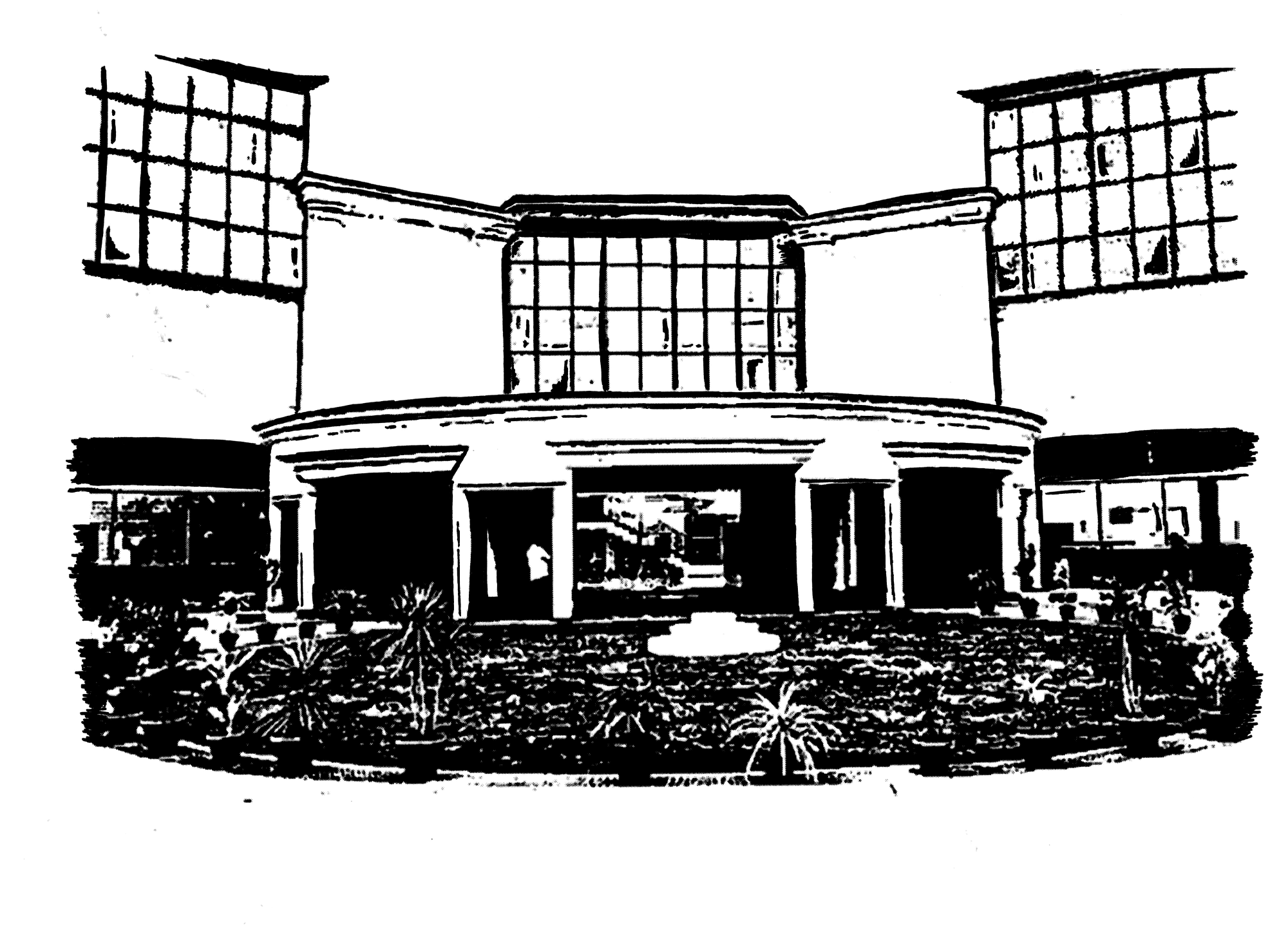Anusheela Chatterjee
(Science Writer, TIFR Hyderabad)
“I shifted to TIFR Hyderabad literally lock, stock and barrel on April 2 (avoided April 1 deliberately!) 2012. Apart from the pleasant surprise of a ready-made Guest House in Aparna Sarovar E1002, there was not much on offer. Srikanth Sastry, who joined with me, promptly left again for JNCASR to put his stuff in order and make the transition in a more orderly fashion after a few months. At that point of time, I had three students in my group: Debabrata Sinha, who was already in Hyderabad before I joined, Chandana Mondal and Saswati Ganguly. I had asked Chandana and Saswati to stay back in Kolkata for a while because they were well ensconced in the hostel at IACS and because I had no idea of any hostel facilities at Hyderabad. There were none. The only thing that existed apart from E1002 was the building in Narsingi – without the partitions and offices. A big open space with just one office to be shared by whomsoever the occupants were. Debabrata made himself comfortable in a room on the terrace. And then we got Mumtaz as the official driver of an official car. In a few weeks, Narsimha joined as our first staff and P. S. Murthy came down from Colaba as our designated administrative officer. Of course, our Centre Director, Rajaram Nityananda, was around. Sriram, VC and Rama had not yet joined. Soon, we had a Centre of sorts with one building, one guest house, one centre director, one faculty, one student, one administrative officer, one staff and one driver. That was the beginning of TCIS.”
As Prof. Surajit Sengupta recollects his initial months at TIFR Hyderabad, one cannot help but marvel at how the institute has grown, in leaps and bounds, since 2012. With the institute still in its ‘pre-teens’, one is presented with a unique opportunity of listening to an interesting mix of people: those who have been associated with TIFR Hyderabad since it were just a concept on paper, those who still fondly recall the time spent in the transit campus at Narsingi, and those who have never tasted Amma’s dosa and tomato chutney.
If you belong to the last category, this article will attempt to tell you a story. “A long time ago in a galaxy far, far away…”
When TIFR Hyderabad was just a concept on paper…
Sometime in mid-2007 (it was probably raining buckets, given Mumbai’s history of monsoons), Prof. Mustansir Barma recalls a particular meeting, with a few of his colleagues in Prof. Sabyasachi Bhattacharya’s office. Prof. Bhattacharya was the director of TIFR Mumbai at that time. It was during this meeting that an idea of a new campus was being explored. Prof. Barma explains that the research in the new campus was envisioned to be rooted in basic sciences while it made inroads into the applied sciences. It was also envisaged that the research in this institute would address questions that would cut across multiple disciplines.
The major driving force behind the idea of an inter-disciplinary institute included Mustansir Barma, Sabyasachi Bhattacharya, K. V. R. Chary, P. K. Madhu, M. Krishnamurthy, B. J. Rao, Krishanu Ray, Shankar Ghosh, Kalobaran Maiti, Arvind Vengurlekar, N. Periasamy, R. V. Hosur, Sanjay Wategaonkar, Deepa Khushalani and S. Ramakrishnan. This idea slowly gained steam and by June 2008, possible sites for the new campus were being surveyed. While scouting for land, Talegaon and Taloja in Maharashtra featured on the list of plausible locations. Following an initial conversation with Prof. K. V. R. Chary, the then government of Andhra Pradesh invited TIFR to consider setting up the new campus in Hyderabad. In response to the invitation, TIFR presented a proposal to the government of Andhra Pradesh on October 15, 2008, requesting for an allocation of land for the new campus of TIFR. Within a month, an area of 209 acres was identified for the proposed campus. This land was barely a kilometre away from the rear gate of the University of Hyderabad campus. This presented a plethora of opportunities to collaborate with one of the most established central universities in the country. There was no looking back. It was decided that the new campus would be established in Hyderabad.

Meanwhile in Colaba, a ‘town hall’ meeting was scheduled. Prof. Barma says, “This term was used to refer to a meeting of all faculty members in TIFR Mumbai. Such meetings are usually quite rare. During one such town hall meeting, I made the idea of a new campus known to the community. The response from the community was quite positive and prompted helpful inputs from all departments and centres. The TIFR Council, who immediately and strongly supported the idea, suggested that we put forward a ‘concept paper’ first.”


Portions of the land that was allocated to TIFR for setting up a new campus in Hyderabad
Now, as all final year graduate students will agree, writing is not an easy task. The team from TIFR Mumbai sat down to write the ‘concept paper’. This piece of writing would outline all the major goals, research themes, academic structure and an estimated strength of the workforce of the institute, along with projected outcomes over the course of several decades. This writing task was a joint effort by many individuals including Prof. Sabyasachi Bhattacharya, Prof. Mustansir Barma, Prof. Rajaram Nityananda, and Uma Mahadevan (an IAS officer). Once this task was completed, the ‘concept paper’ was presented to the TIFR Council. In the month of July 2010, this was approved by both the TIFR Council and the Atomic Energy Commission (AEC).
On October 19, 2010, the Prime Minister of India, Dr. Manmohan Singh, unveiled the foundation stone of the new campus.
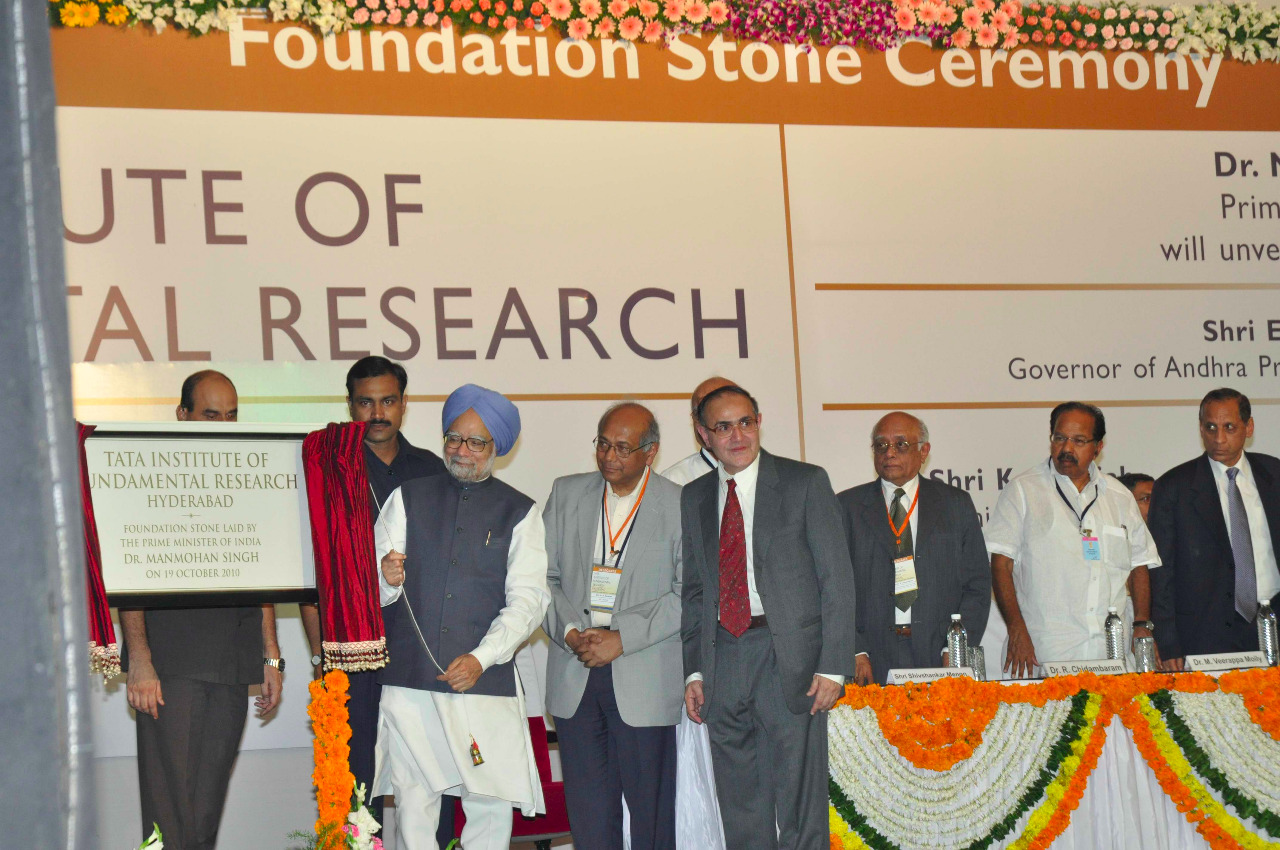
Unveiling of the Foundation Stone
A bigger task lay ahead. Prof. P. K. Madhu says, “Later that year, sometime around November, two brainstorming sessions were held to plan for the initial academic focus areas at TIFR Hyderabad. One of these sessions was chaired by Prof. C.N.R. Rao (Member, Council of Management, TIFR) and the other by Dr. S. Banerjee (Chairman, AEC).
At the end of 2010, TIFR Center for Interdisciplinary Sciences (TCIS, the first centre of TIFR Hyderabad) was proposed and funding was allocated by the DAE for the infrastructural and research initiative.”
This set the ball rolling.
“O Transit campus, My Transit Campus!”
The construction of the new campus would happen over a course of time. It was imperative to search for a potential temporary working space in order to begin research activities as soon as possible. By December 2010, ‘Plot No.21, Brundavan Colony’ at Gandipet was earmarked as the building where the research facilities would be set up, temporarily.
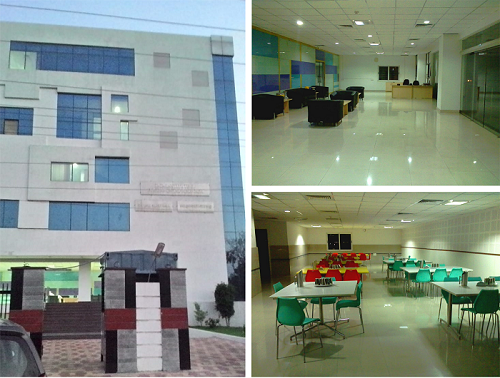
The transit campus at Narsingi
Prof. V. Chandrasekhar describes his first visit to the transit building, “I came to the transit building, in 2011, along with Rajaram Nityananda. There was a building opening ceremony by breaking a pumpkin. My joining at TCIS was still a year away. The place was very remote; there was no human movement, forget about road traffic!”
Prof. Rajaram Nityananda was the first centre director. He was one of the first occupants of the transit campus when it had hardly any semblance to a research institute. Rumour has it that he used to cycle for around twelve kilometres from the University of Hyderabad to the transit campus and back, every single day. Eager to hear about his experience at TCIS and more so, to verify this urban legend, I reached out to Prof. Rajaram Nityananda over email. Turns out, every bit of it was true. Golly!
Prof. Nityananda narrates, “Vijayadasami, 2011: A festival often associated with beginning academic activities, and here I was with the biggest office of any Indian scientist, all 40,000 square feet of it, sitting in front of a computer, debugging a misbehaving programme. Herculean efforts from a large team in Colaba had created this project – the TIFR Centre for Interdisciplinary Sciences, and rented this building in Gandipet. University of Hyderabad had graciously provided boarding, lodging on its campus, an office with great company in the physics department and a dozen enthusiastic students for an astrophysics elective – so this phase was by no means as lonely as it sounds. The vast UoH campus and the verdant surroundings at Gandipet inspired me to buy and use a second hand bicycle. Talking of inspiration, I remember going to lunch in the buffet area of the University guest house and seeking the nearest chair, from which I saw the sprightly figure of C. R. Rao, legendary statistician and more than quarter of a century my senior, standing in animated discussion with his colleagues – I learnt he was revising his book on linear statistical inference!
The first pair of adventurous faculty and one student joined TCIS in April 2012, and my successor in June, and the rest is history. It was my privilege to hold the fort, however briefly. TCIS is now a flourishing fortress of interdisciplinary science, populated by both new entrants and some of the colleagues in Colaba, who worked so hard to make it happen.”
Prof. Rajaram Nityananda was succeeded by Prof. Sriram Ramaswamy. Despite the obvious difficulties which stared at the face of the researchers, the institute pushed itself to conduct research of the highest standards. Interestingly, an excerpt from Dr. Homi Bhabha’s speech during the stone laying ceremony of the buildings in TIFR Mumbai reads the following:
The foundation stone is being laid today 8½ years after the Institute was founded. This is perhaps not quite as it should happen — but to some extent it should, because the real thing that matters is the work that is done. I remember when the Institute was opened, the Chairman of the Council in his speech said, “We have not in the usual way waited for the completion of new buildings before commencing our research activities, but have, so to speak, plunged ‘in medias res’. I regard this as a happy augury for the future because, in creative work of this kind, what matters most is the enthusiasm of those concerned with it.”
Prof. V. Chandrasekhar says, “In the initial weeks, we had no canteen. During this period, owners of the building supplied food to us. We organized a canteen which later got transformed into Amma’s canteen. Mr. Srinivasan came down from TIFR Mumbai and helped us in partitioning the space and creating the labs, auditorium, and lecture halls.”
By 2012, students had started trickling in and a robust graduate programme was designed to make sure that their foundations were strong. In the initial years, graduate programmes in physics and chemistry were introduced. The graduate programme in biology was initiated in 2015. The students had to complete the coursework in a designated amount of time. They had to choose from a wide variety of courses, both core and elective ones to fulfil their credit requirement. Students were encouraged to take courses from a range of disciplines, rather than restricting themselves to familiar turf. This helped foster the ‘inter-disciplinary’ outlook of the institute, right from the very beginning. The proximity to the University of Hyderabad campus promoted a steady exchange of knowledge. While some members of the TIFR faculty taught courses at the university, a few students took courses on Statistical Mechanics (2012), Dynamical Systems and Chaos (2013), and Cancer and Stem Cell biology (2015) at the university.
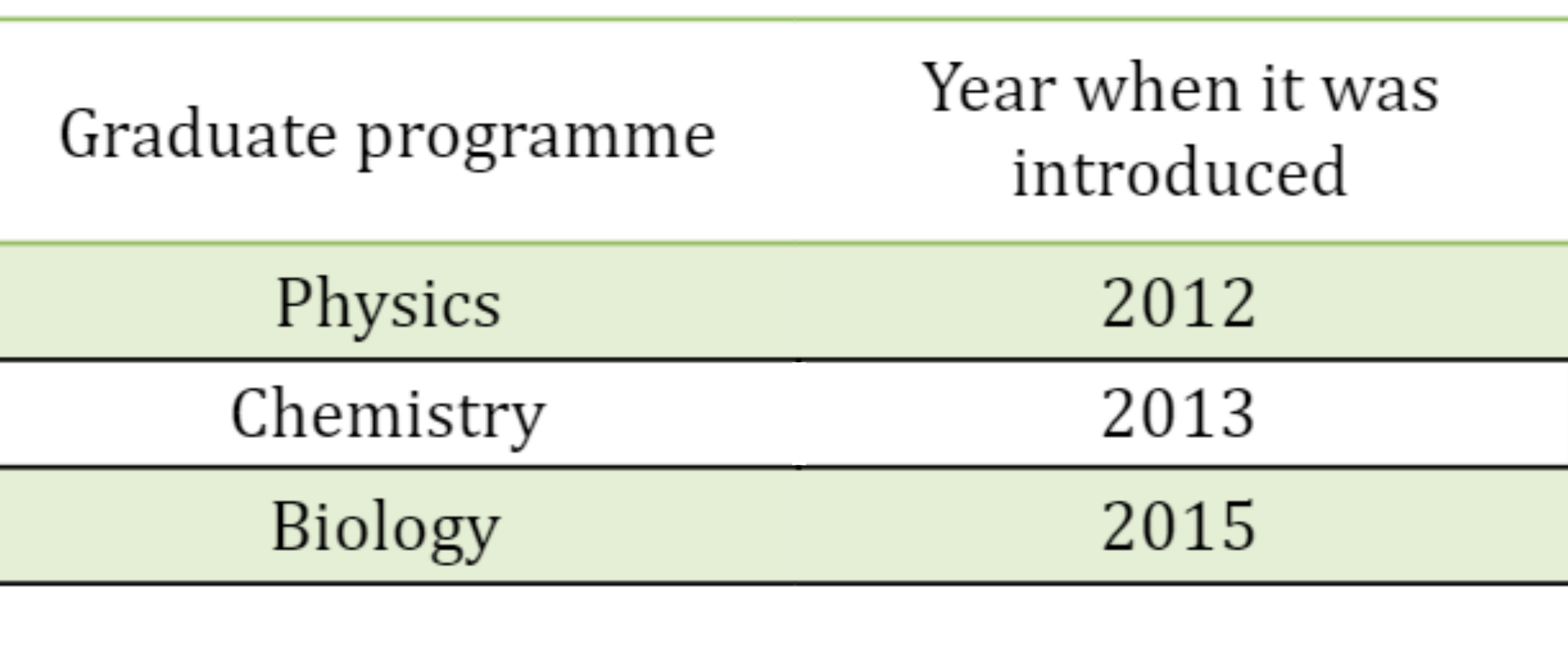
In addition, the students were required to complete small-time projects in a few labs, mostly to zero in on a lab of their choice for pursuing their PhD. Most of the initial students were instrumental in setting up of the labs. In due course of time, the transit campus housed state-of-the art lasers, high performance computers and x-ray spectrometers. It was decided that a high field NMR facility would be built in the premises. Dr. G. Rajalakshmi narrates the first hiccup while installing the mammoth spectrometers, “The high-field NMR facility started with the arrival of the 700MHz NMR machine from Bruker, Switzerland in October 2015. The 1.2 tonne machine came to the transit campus at Narsingi and it was to be installed in the ground floor. The task of unloading the machine from the trunk and taking it to the ground floor, which was actually one level up from the road, was an adventure in itself. A crane had been hired to help us with the task but to our horror, when we tried to lift the wooden box with the NMR magnet off the truck, we noticed that the base of the box was falling off! The ingenious crane driver helped us safely get the magnet into the building and to its appointed location without any calamity. The experience prepared us well for future installations and the move from transit to the main campus.”
The institute began considering opportunities for engaging with the people of Hyderabad. Lab tours for school students were a recurring event but there had to be some way in which the scientists could interact with the general public, if possible on a regular basis. This led to the start of a science café called ‘Sawaal-Jawaab’ in Lamakaan, Hyderabad. This initiative was steered by Prof. Shubha Tewari. On October 19, 2013, the first ‘Sawaal-Jawaab’ session took place. Prof. Sriram Ramaswamy spoke about ‘Flocks, herds, swarms: The physics of moving in groups’ in a manner that was easily understandable by the layperson. This became a regular event and in some ways, marked the beginning of science outreach activities in TIFR Hyderabad.

The poster of the first ‘Sawaal-Jawaab’ session
Though their number was less, it never stopped the students from piecing together a vibrant campus life. The seating areas for the students were located on the third and fourth floors of the building. The students sat together, and were not grouped on the basis of their discipline, no pun intended. An experimental physicist sat in a room with a theoretical physicist, a biologist and a material scientist for company. Folklore goes that a group of students would crowd around one system and play a game of chess online. Each game had to bear the brunt of the combined intellectual onslaught of all the participants. Chess was not the only sports activity that students indulged in. Along with a night canteen, the roof harboured provisions for table tennis.
Prof. Sriram Ramaswamy stressed that along with research and teaching, it was important to “keep student morale up through excursions or pack everyone into the Winger to go to a movie”, he continues, “To cool off after our highly vocal faculty meetings we’d go down the road to eat amazing gelato at Sandwich-O. Sometimes we’d skip canteen lunch in favour of samosas at Pandeyji’s stall across the road.” Till date, every student who has spent some time in the transit building fondly recalls their interactions with Prof. Sriram Ramaswamy and Prof. Rama Govindarajan. Both of them fostered a culture where students could easily approach faculty when faced with any problems.
Dr. Sharath Jose, a former graduate student, says, “On coming to TCIS back in 2012, Narsingi was far removed from the environs of IISc and JNC that I had become accustomed to over the preceding two years. The TCIS building was by the (then scenic) highway leading to Shankarpalli and a couple of kilometers from Narsingi village. The terrace offered a place to relax and reflect in the evenings as one gazes over the surroundings filled with thorny shrub. On moving a little away from the road, one comes across a dry riverbed where one can find goats and buffalos grazing. Flocks of peacocks were not an uncommon sight, with them offering spectacular scenes of flight during the Monsoons. The few that we were, we relished stepping out of TCIS as a group – for tea, going to Osman Sagar, getting into the city etc. Unorthodox place for a research institute – maybe! But it certainly served as a setting for lots of interesting memories.”
While research activities progressed in the transit campus, preparations were underway to relocate to the permanent campus at Gopanpally. The team which were working towards taking this project to completion had grown bigger- Dr. Jayant Kayarkar (Registrar of TIFR) made multiple trips to Hyderabad while Prof. R. G. Pillay and Prof. E. V. Sampathkumaran contributed to the detailed project and financial planning. Prof. Barma recalls that the faculty members had extensive discussions on the design of spaces in the new campus. An enormous amount of planning had gone into the design of unique student seating areas, presence of parallel service corridors behind the labs and an open space meant for discussions. Theorists will endorse this: blackboards are necessary and this is non-negotiable. A father-son duo, local residents of Hyderabad, was entrusted with the responsibility of manufacturing the blackboards for the new campus. Prof. Barma later said, “Those were the finest blackboards that I have ever seen.” Architectural plans for the First Research and Teaching Building (FReT-B) were drawn up by Anshu Gupta from the Directorate of Construction, Services and Estate Management, DAE. The construction of FReT-B began in July 2012.

The shift to the permanent campus
There’s no point denying this- the worst thing about shifting to a new house is the process of shifting itself. Packing off an entire research institute- lasers, spectrometers, heavy-duty microscopes, other lab equipment, furniture, students, faculty, staff et al. – to a new address was an enormous task. This shift began on June 28, 2017. By October 31, 2017, all the labs had been shifted to the big white building near Gopanpally Thanda.
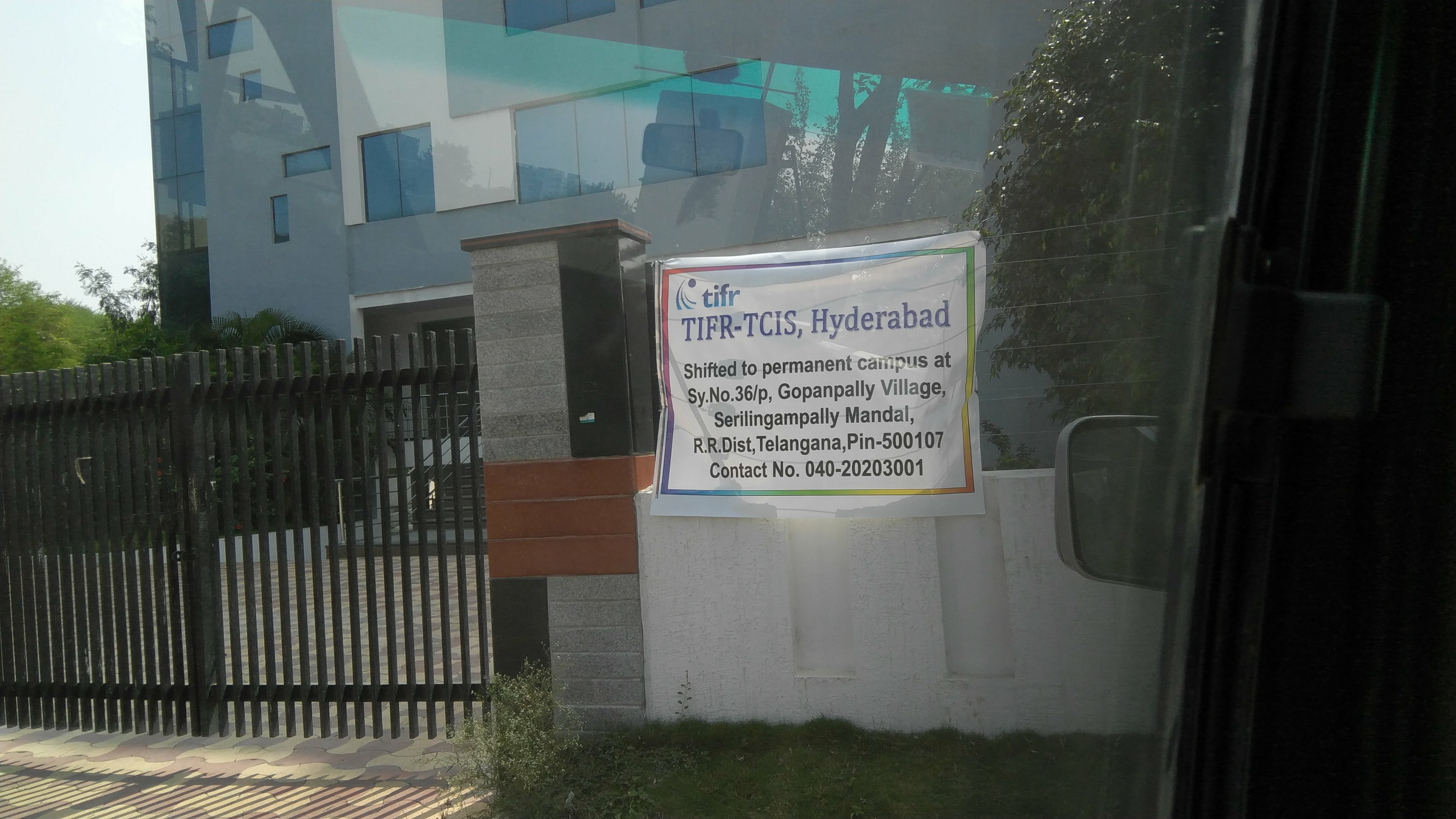
A signage outside the transit building that announced the shift to the new campus.
Since then, the institute has seen a lot of changes, positive ones mostly. The left wing in the ground floor boasts of a National High-Field NMR facility with six spectrometers. The right wing on the same floor provides healthy competition by lodging a clean room with a high power 0.5 terawatt Ti:Sapphire laser. A molecular beam epitaxy chamber and a scanning tunneling microscope have been coming extremely handy in condensed matter physics experiments. A High Performance Computing Cluster sits pretty in one of the service buildings. There are five biology labs in the institute at present. With fully functional chemistry and biophysics labs, and spacious classrooms, the institute has been expanding steadily. The interactions with the University of Hyderabad have increased- be it regular Life Science and Chemistry seminars or science communication activities. The institute appeared on social media platforms and very soon became one of the ‘Twitterati’. Additionally, it has full-fledged activities which are aimed at providing a boost to the science education in schools.
From one student to ninety five research scholars, from 40,000 square feet to 100, 000 square feet, from concept to a reality, TIFR Hyderabad has traversed one long journey. When one stands on the terrace of FReT-B, s/he is greeted by a huge expanse of land. The land shall soon house a world-class interdisciplinary research and teaching institute; and when that happens, it shall make another great story.

TIFR Hyderabad, 2019

A timeline of events
Acknowledgements:
Prof. Mustansir Barma, Prof. P. K. Madhu, Prof. M. Krishmamurthy, Prof. Surajit Sengupta, Prof. Sriram Ramaswamy, Prof. Rajaram Nityananda, Prof. V. Chandrasekhar, Dr. G. Rajalakshmi, and Dr. Sharath Jose for sharing their experiences.
Prof. Mustansir Barma, for extensive discussions about the events that led to the formulation of the ‘concept paper’ and other valuable inputs.
Prof. M. Krishnamurthy, Prof. P. K. Madhu, Dr. Raghunathan Ramakrishnan, S. V. Rahul and Parswa Nath for providing with photographs.
Ms. Ananya Dasgupta for her help in providing excerpts from Dr. Homi Bhabha’s speeches.
The students of TIFR Hyderabad, who had spent their initial years of graduate school in the transit campus, for sharing their experiences.
Ms. Roopashri Prasad and Ms. P. Hemalatha for providing with the dates of important events.

